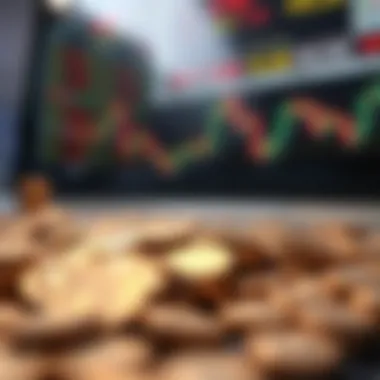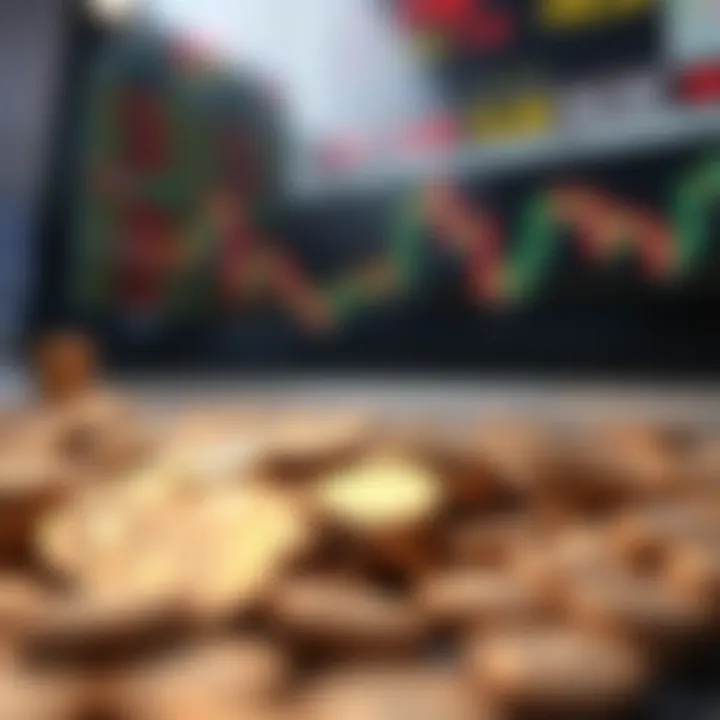Understanding the Benefits of Buying Put Options


Intro
In the world of investing, the concept of put options can be a bit daunting for many, yet understanding their value is essential for enhancing one’s financial toolkit. Put options serve as a unique instrument in an investor's arsenal, providing not just a way to hedge against declines in stock prices but also opportunities for profit during market downturns. This article unravels the strategic importance of buying put options, shedding light on when and how to use them effectively in an investment portfolio.
To get a better grasp of put options, diving into some key terminologies and strategies will set the foundation for our discussion. Let’s navigate through these concepts to ensure we all start on the same page.
Investment Dictionary
Key Terms and Definitions
When diving into any financial instrument, familiarity with the lingo is crucial. Below are essential terms related to put options:
- Put Option: A financial contract that gives the holder the right, but not the obligation, to sell a specified quantity of an asset at a designated price (strike price) within a specified time frame.
- Strike Price: The price at which the underlying asset can be sold when exercising the option.
- Expiration Date: The date by which the option must be exercised or it becomes worthless.
- Premium: The price paid to purchase the put option, a cost that the investor must consider when analyzing potential returns.
- In-the-Money (ITM): A put option is considered ITM when the market price of the underlying asset is below the strike price.
- Out-of-the-Money (OTM): A put option is OTM when the market price of the underlying asset is above the strike price.
These definitions lay a crucial groundwork, allowing us to facilitate deeper discussions around strategies and risks associated with put options.
Common Investment Strategies
Investors use various strategies when engaging with put options; understanding these helps in deciding when to opt-in or sit tight. A couple of common strategies include:
- Hedging: Buying puts can act as insurance against potential losses in a stock position. If the market falls, the puts increase in value, offsetting the loss in the asset.
- Speculation: Traders might also buy put options in anticipation of a decline in a stock's price, aiming to profit from the downward movement.
By utilizing these strategies, investors can tailor their approach based on their market outlook and risk tolerance.
Expert Advice
Tailored Investment Strategies
While knowledge of strategies is essential, creating a customized approach is key to success. Assess your current portfolio:
- Identify which assets may need hedging.
- Decide the lengths of time you're willing to invest in options, aligning with your overall investment goals.
Engaging with a financial advisor can offer tailored advice based on your financial landscape. Each investor’s situation is unique, and strategies should align with personal financial goals and market conditions.
Risk Assessment and Management
Investing in put options isn’t without its risks. For instance, a misjudgment of market movement could lead to a total loss of the premium paid. Therefore, employing robust risk management techniques can mitigate exposure:
- Diversification: Don’t put all your eggs in one basket. Mix various strategies alongside your use of puts.
- Regular Monitoring: Keep a keen eye on market trends and reassess your options often.
In summary, the potential of put options lies well within the reach of the insightful investor willing to educate themselves on this derivative. Navigating the waters of market volatility can be daunting, yet with sound strategies and diligent research, financial enthusiasts can cultivate resilience and adaptability in their investments.
"Investing without strategy is like sailing without a compass; you may end up where you don’t want to be."
For further insights on options and investing strategies, resources like Investopedia and the SEC's Investor.gov provide valuable educational material for both novice and seasoned investors.
Preamble to Put Options
In the vast realm of investing, put options are a pivotal tool that savvy investors utilize to manage risk and strategize their portfolios. Understanding the dynamics of put options is crucial, as they offer a safety net during market downturns, allowing investors to maintain a level of control over their investments. The concept may appear daunting at first, yet, once dissected, it becomes evident how vital this financial instrument is for enhancing investment strategies.
Definition of a Put Option
At its core, a put option is a contract that grants the holder the right, yet not the obligation, to sell a predetermined amount of an underlying asset at a specified price, known as the strike price, within a designated time frame. This is generally measured in expiration dates, ranging from a few weeks to several months. Essentially, buying a put option gives investors the ability to hedge against falling prices.
For instance, consider an investor who believes that shares of a company, let's say Tech Innovations Corp, will decline in value. By purchasing a put option for these shares, the investor can sell them at the agreed strike price, regardless of market price at expiration. This serves as a form of insurance against their investment's devaluation, allowing for potential profit even in a declining market. In simpler terms, it’s like having a safety parachute when jumping from great heights—you hope not to use it, but it is comforting to know it’s there.


Mechanics of How Put Options Work
Understanding how put options function involves several moving pieces. When an investor purchases a put option, they pay a premium, which is the price of the option itself. This premium is the cost for acquiring the right to sell the underlying asset at the strike price. The value of a put option rises when the price of the underlying asset falls and decreases when the price rises. Hence, timing and market conditions significantly influence this mechanism.
- Buying a Put Option: An investor believes that the market price will drop. They buy a put option with a specified strike price.
- Premium Payment: The premium paid provides the investor the right to sell the underlying asset.
- Exercising the Option: If the market price drops below the strike price before expiration, the investor can exercise the option, selling at the agreed price, thus realizing a profit.
- Expiration: If the underlying asset’s price does not fall below the strike price before the option expires, the put option may become worthless, and the investor loses only the premium paid.
This mechanism can be likened to a bet on market behavior. An investor places this bet by paying the premium, and the outcome hinges on market movements. While it can appear complicated, breaking it down into these steps illustrates the straightforward function of put options within an investment portfolio. They not only provide an opportunity for profit but also serve as an effective risk management tool in uncertain markets.
Understanding these fundamental aspects serves as a foundation for exploring the broader strategic significance of purchasing put options. They are not merely a financial instrument; they represent an opportunity for proactive engagement within complex market dynamics.
Reasons for Purchasing Put Options
Understanding the reasons for purchasing put options is crucial for anyone looking to enhance their investment strategy. These instruments can serve multiple purposes, each linked to a deeper understanding of market dynamics and individual risk tolerance. Investors often find value in put options for several reasons, primarily involving risk management, speculation on future price movements, and diversification of their portfolios. Below, we delve into these facets to illuminate their significance in investment decisions.
Hedging Against Market Declines
One of the primary motivations for acquiring put options is their effectiveness as a hedging instrument. Imagine you're a stockholder worried about the nearing earnings report and the uncertainty it might bring. Rather than selling off your shares, you can buy puts as a protective measure. By purchasing a put option, you gain the right to sell your stocks at a predetermined price, known as the strike price, even if the market tanks. This strategy enables you to safeguard your investment against unexpected downturns.
Put options act as a safety net, cushioning you from adverse price movements. The beauty lies in their inherent structure, which allows investors to maintain ownership of their underlying assets while managing risk. In a tumultuous market, where volatility is the name of the game, investors can reap the rewards of stability offered by put options.
Speculating on Price Movements
Aside from hedging, put options also serve as a vehicle for speculation on potential price descending movements. Investors who have a hunch that a particular stock is due for a tumble might decide to purchase put options. This form of investment can yield considerable returns when market dynamics shift in favor of the investor’s prediction. For example, if you anticipate that XYZ Corporation's share price will drop from $100 to $70, buying a put option can allow you to sell the shares at the higher strike price, leading to profit when or if the market adjusts.
This strategy is appealing as it requires less capital than directly shorting a stock. You essentially can profit from declining markets without the need for a large margin, which can escalate risks. Additionally, put options can amplify returns because the leverage involved means a small drop in the underlying asset can turn into significant gains proportional to the premium spent on the option.
Enhancing Portfolio Diversification
In any well-rounded investing strategy, portfolio diversification stands as a pillar of risk management. Purchasing put options can provide an added layer of diversification. While stocks typically make up the bulk of a typical investor's portfolio, incorporating put options brings flexibility in positioning during uncertain market conditions. Instead of simply holding an all-equity portfolio, you can strategically integrate options.
This use of options can not only mitigate risk but can also introduce a new dimension to your returns profile. By employing put options, you're essentially adding non-correlated assets to your portfolio. When the equity market is struggling, your put options may perform favorably, assisting in offsetting losses from other investments. Thus, understanding how and when to utilize put options can bolster your portfolio’s stability and enhance overall performance.
In summary, the importance of purchasing put options centers around effective hedging strategies, speculating on price movements, and diversifying your investment portfolio. Each element highlights how put options provide investors with tools to navigate the financial markets more safely and strategically. For further insights, one might explore resources like Investopedia or articles on Seeking Alpha to see real-world applications and detailed analyses.
The Role of Market Volatility
Market volatility plays a crucial part when considering the value of put options in investment strategies. Simply put, volatility indicates how much and how quickly the value of an asset can change. For investors, understanding this concept is a necessary key for making informed decisions. With the ever-present uncertainty in financial markets, knowing how volatility interacts with put options is essential for effective risk management and maximization of returns.
Volatility is fundamentally linked to investor sentiment and economic conditions. If the market is anticipating higher price swings, the worth of put options can rise sharply. This rise is primarily due to the increased chance of the stock price dropping, which means the put options become more valuable.
One significant aspect to keep in mind is the distinction between historical volatility and implied volatility. Historical volatility measures past price movements, while implied volatility helps predict future movements, reflecting market expectations. During periods of high implied volatility, options premiums can be hefty. Thus, for investors, timing their purchase of put options in relation to volatility changes can make a substantial difference in their financial outcomes.
High implied volatility often results in greater premiums for options, as risk and uncertainty escalate.
In summary, market volatility serves as a double-edged sword when it comes to buying put options. It can enhance the potential rewards but also amplifies risk. Investors must embrace volatility as a vital component in their strategy, leveraging it to their advantage without falling prey to emotional decision-making. Understanding how volatility influences put option pricing can lead to better risk management and strategically timed investment actions.
Understanding Implied Volatility
Implied volatility (IV) is the market's forecast of a likely movement in an asset's price. It’s a critical factor that investors should consider when looking at put options. IV reflects the market's expectations of future volatility over the life of the option. Unlike historical volatility, which looks at past data, implied volatility is forward-looking, allowing investors to gauge how much the market thinks an asset's price might fluctuate.
When IV is high, it indicates that investors are expecting the stock’s price to experience larger swings, whether up or down. Conversely, a low IV suggests more stability is in the cards. The catch here is, when implied volatility spikes, it often inflates the prices of options, including puts. Investors need to carefully analyze the relationship between implied volatility and the actual price movements in the underlying asset to make prudent buying decisions.
Correlation Between Volatility and Put Options Pricing
The relationship between volatility and the pricing of put options is not just a swing in prices, but a calculative art. Generally, higher volatility leads to higher premiums on put options. This correlation arises because increased volatility raises the odds of the underlying asset declining below the option's strike price. Thus, sellers of put options demand higher premiums to compensate for potential risk.
For investors, this implies that understanding market conditions and timing can significantly impact their investment's effectiveness. During stable market periods, option prices often decrease, reflecting low implied volatility. Therefore, savvy investors might attempt to purchase put options during these times in anticipation of future volatility spikes. A careful watch on economic indicators, news that affects investor sentiment, and upcoming earnings reports can also provide insights on where volatility might head next.


In essence, recognizing the intricacies of how volatility interacts with put option pricing is a fundamental skill for any serious investor. This knowledge doesn't just help in managing risk but also indicates when to enter or exit positions effectively.
Risk Management Considerations
Understanding the role of risk management when engaging with put options is paramount for any investor aiming to navigate the complexities of the financial markets. Put options can act as a powerful tool in mitigating financial loss and stabilizing an investment portfolio during volatile times. By buying put options, investors essentially acquire the right to sell an asset at a predetermined price, known as the strike price, within a specified timeframe. This right can serve as a safety net, helping to limit potential losses.
Limitations of Put Options as a Risk Management Tool
While put options offer investors significant protective benefits, they are not without their drawbacks. Here are some key limitations to keep in mind:
- Cost: Purchasing put options involves paying a premium. This upfront cost can eat into profits, especially if the expected downturn doesn't happen.
- Time Decay: As the expiration date of the option approaches, the time value decreases. If the asset does not move significantly, the value of the option might erode quickly, leading to potential losses.
- Market Movement: If the market shifts unpredictably, the put option may become worthless, especially if the asset price exceeds the strike price.
Ultimately, while put options do provide a risk management strategy, investors must balance these drawbacks against their protective benefits. It's also important to integrate them into a broader investment strategy that considers their unique limitations.
Scenario Analysis for Effective Hedging
To effectively leverage put options for risk management, investors should conduct a scenario analysis to assess potential market fluctuations. This involves evaluating how different scenarios—like market crashes or economic downturns—can impact their portfolios. Here’s a breakdown of how to approach it:
- Identify Key Variables: It’s important to understand which external factors will likely affect the assets. For example, consider economic indicators, industry developments, and geopolitical factors.
- Create Different Scenarios: Formulate various market scenarios, such as a ten percent drop, or a major economic collapse. What will that look like for your portfolio?
- Analyze Put Option Performance: For each scenario, estimate how the put option would perform. Would it safeguard your investment, or would the premium negate the benefits?
- Adjustment Plans: Based on this analysis, develop clear strategies on when to activate the put options or possibly exit the market entirely.
Engaging in scenario analysis allows for a proactive approach to risk management. By simulating market conditions, investors can better understand the practical implications of their hedging strategies and adjust their investment decisions accordingly.
> Navigating the financial landscape is as much about understanding your tools as it is about anticipating market behavior. The strategic use of put options can serve as both a shield against losses and a method to recalibrate your investment approach.
With these insights, investors can appreciate how to utilize put options effectively as part of a comprehensive risk management strategy. Ensuring clarity on both the benefits and limitations can allow for informed decisions that align with broader financial goals.
Determining When to Buy Put Options
When it comes to the investment game, timing is often half the battle. Buying put options isn’t just about knowing how they work; it’s just as crucial to understand precisely when to pull the trigger. Investors need to have a keen sense of market conditions, as well as a solid grasp of factors influencing option expiration. The stakes are high, and the right timing can make all the difference.
Analyzing Market Conditions
Market conditions can create a plethora of opportunities or pitfalls when it comes to options trading. One fundamental step is to analyze the broader market trends. Investors should observe whether the market is bullish or bearish. For example, during a downturn, buying put options can shield against further declines. Tracking stock market indices, such as the S&P 500 or Dow Jones, can offer insights into broader trends.
- Economic Indicators: Keep an eye on economic indicators like unemployment rates or GDP growth. If indicators point to a recession, the likelihood is that stock prices may dip.
- Sector Performance: Some sectors might outperform others during specific market phases. If tech is down but healthcare is stable, knowing where to deploy capital becomes vital.
- News Events: Geopolitical tensions or earnings reports can swing market moods dramatically. Being quick to respond to relevant news can provide a strategic advantage.
A practical approach might be to assess sentiment through indicators like the Fear & Greed Index. A market steeped in fear often suggests that the timing is ripe for purchasing put options.
Timing and Expiration Factors
Timing goes beyond just the choice of moment; it also involves understanding expiration dates for your puts. Options are time-sensitive instruments, and their value can erode swiftly, a phenomenon known as time decay. Thus, being aware of your position's expiration can be crucial.
- Short-Term vs. Long-Term: Investors vary in their approach. Some prefer short-term trades that capitalize on quick price swings, while others may opt for long-term positions to weather volatility. If you’re betting on a sharper decline within weeks, short-term puts are appropriate. On the other hand, longer-dated puts may be necessary if you anticipate a significant downturn over months.
- Strike Prices: The choice of strike price can also influence timing. A put with a higher strike price can provide more protection against declines but comes at a premium. Balancing these factors requires vigilance and strategy.
- Earnings Seasons & Major Announcements: Anchoring your purchase of puts around significant financial announcements or earnings reports can be a savvy approach reveals the market's expectations and ensuing volatility.
Evaluating the interplay of these variables aids investors in crafting a well-rounded strategy. It isn't merely about deploying capital but aligning it thoughtfully based on astute analysis.
"In the world of finance, patience is not just a virtue; it’s a key ingredient for success."
Understanding when to buy put options equips investors with strategic defenses against market uncertainty. With market conditions and expiration factors in mind, decision-making becomes not only informed but potentially lucrative.
Financial Implications of Buying Put Options
Understanding the financial implications of buying put options is essential for investors aiming to navigate the complex world of derivatives. It encompasses more than just the upfront costs; it's about grasping the complete picture of how a put option fits into an overall investment strategy. From balancing risk with reward to considering the timing of market movements, each layer adds depth to the decision-making process. Knowing these factors allows investors to optimize their portfolios effectively and strategize smartly about potential outcomes.
Cost Considerations and Premiums


When one buys a put option, the first financial aspect to consider is the premium—the price paid for the option itself. This cost can be likened to an insurance policy. Just as you pay a premium for peace of mind, buying a put option incurs a cost that guarantees the right—though not the obligation—to sell an asset at a predetermined price.
The premium is influenced by several factors:
- Intrinsic Value: This is the difference between the strike price and the current market price of the asset. If the market price is lower, the intrinsic value is more substantial, typically leading to higher premiums.
- Time Value: Options don’t last forever; they have an expiration date. The more time an option has until it expires, the higher the time value, and thus, the premium tends to be bigger. It’s like holding on to a ticket with a later expiration—more days mean more chances for the value to increase.
- Market Volatility: High volatility usually leads to higher premiums, reflecting the greater uncertainty and potential for price swings. It’s analogous to the urgency felt during a storm—higher risk increases the protective barrier you’re willing to pay for.
Investors should calculate whether the potential returns justify the costs associated with put options. If the anticipated price movement is significant enough, it could outweigh the initial premium, making the investment worthwhile.
Evaluating Potential Returns
Evaluating the potential returns from buying put options is critical for investors looking to maximize their gains. The return on investment from a put option can be significant, but it requires careful analysis of several factors. A good grasp of how returns are calculated can truly make the difference between a successful trade and a missed opportunity.
To measure potential returns, investors need to consider:
- Exercise of the Option: If the market price falls below the strike price, the investor can choose to execute the option. The profit here is calculated as the difference between the strike price and the market price, minus the premium paid. This straightforward formula helps evaluate profitability.
- Market Movement Scenarios: Investors should anticipate different market movement scenarios. What happens if the market swings wildly, or holds steady? Crafting a few "what-if" scenarios can help visualize potential outcomes and returns.
- Return on Investment (ROI): It’s essential to assess the ROI based on the total investment, including the premium. A common formula investors might use is:
This helps quantify how effectively the premium was leveraged against capital.
In essence, understanding both the costs associated with purchasing put options and the potential returns can empower investors to make informed decisions. By analyzing these financial implications through a critical lens, investors can enhance their strategic positioning in the market.
Many sophisticated investors appreciate that the real strength of options lies in their flexibility and potential for profit, provided one has done their homework thorough.
For more detailed insights, you may refer to resources like Investopedia and Wall Street Journal for real-world examples and case studies.
Case Studies: Successful Use of Put Options
When it comes to investing, theory can only take you so far. Real-world examples provide insights into the practical applications of options, particularly put options. By examining case studies, we can unearth the strategies employed by different players in the market. These narratives highlight how put options can be a powerful tool when wielded correctly. Understanding these case studies is essential for both institutional investors and individual traders, as they highlight the tangible benefits and considerations associated with using put options effectively.
Institutional Examples
Consider major investment firms like Goldman Sachs and their strategic application of put options during market downturns. In 2008, when the financial crisis loomed, many hedge funds began buying put options on various financial instruments. One firm opted to purchase put options on the S&P 500 index, aiming to protect their extensive portfolio. By doing so, they not only safeguarded their investments against potential loss but also positioned themselves to capitalize on the subsequent market volatility.
These institutional players often have substantial insights and the resources to make informed decisions. Their strategies typically involve extensive analysis of market conditions, allowing them to choose the right time to enter the put options market. For instance, they might assess indicators like implied volatility, ensuring they’re buying puts when prices are favorable. This example demonstrates that when institutions buy put options as a hedge, it often results in not just preserving capital but also generating impressive returns when the market dips.
- Protective Positioning: Institutions use puts to offset losses in their portfolios, a strategy that ensures they aren't entirely exposed to market fluctuations.
- Market Forecasting: By accurately predicting declines, firms can enhance returns, leading to a more robust overall strategy.
- Liquidity Management: Puts also provide liquidity in times of panic, offering an instant avenue for exiting positions without incurring large losses.
Individual Investor Experiences
On the grassroots level, individual investors can learn valuable lessons from successful case studies. Take Sarah, for example, a retail investor who was concerned about her tech-heavy portfolio amidst increasing regulatory scrutiny on technology companies. Unsure of how the market might shift, Sarah decided to purchase put options on a leading tech stock.
When the anticipated downturn occurred, Sarah's put options gained significant value, effectively offsetting the losses she faced on her actual stock holdings. This agile response to market conditions showcased how a well-timed purchase of puts could cushion an investor from the sharp edges of volatility.
Key takeaways from Sarah's experience include:
- Timely Decisions: Making quick, informed decisions based on market signals can yield protective benefits.
- Flexibility: Individual investors have the distinct ability to pivot quickly without the constraints that institutional mandates sometimes impose.
- Learning Curve: Each use of options, whether successful or not, adds to an investor’s understanding of market dynamics and their own trading psychology.
"In the world of investments, being prepared can make the difference between a minor setback and a catastrophic loss. Put options offer that buffer when used wisely."
As these case studies illustrate, whether one is tackling immense portfolios at a firm like Goldman Sachs or managing personal finances, the strategic use of put options can play an instrumental role in navigating uncertainty. Investing isn't just about what you buy; it's also about how you protect what you have, and understanding these real-world applications of put options is vital for any serious investor.
Closure
Recap of Key Points
In revisiting the main highlights of the article, we see that:
- Definition and Mechanics: Put options provide investors the right to sell an underlying asset at a predetermined price, thereby protecting against potential declines in the asset's value.
- Reasons for Purchase: Investors often turn to put options to hedge against market downturns, speculate on future movements, or enhance portfolio diversification.
- Market Volatility: Understanding implied volatility is crucial, as it plays a significant role in the pricing of put options. Higher volatility typically raises the premiums for these options.
- Risk Management: While put options can offer significant protection, they also have limitations. A balanced approach, including scenario analysis for effective hedging, is essential.
- Timing and Market Conditions: Knowing when to buy put options involves careful analysis of market conditions and expiration factors, which requires both skill and experience.
- Financial Implications: The cost of purchasing put options, including premiums, plays a critical role in assessing their potential return on investment.
- Case Studies: Real-world examples demonstrate that both institutions and individual investors have successfully utilized put options to navigate various market scenarios.
Final Thoughts on Strategic Use of Put Options
In closing, the strategic use of put options is not simply a tool for speculation; it represents a nuanced approach to investing that acknowledges the unpredictability of financial markets. By incorporating put options into one’s investment strategy, individuals can potentially hedge against losses and capitalize on market opportunities.
It is essential to approach put options with a clear understanding of their mechanics and implications. This includes a well-defined risk management strategy and awareness of the complex interplay between market conditions. By doing so, investors not only enhance their financial acumen but also position themselves to make more informed and deliberate investment choices.
As the financial landscape continues to evolve, grasping the intricacies of options trading will undoubtedly empower investors, enabling them to utilize strategies that align with their unique financial goals and risk tolerance. Ultimately, it’s not just about what options one holds, but how effectively they are employed within the greater context of an investment strategy.



